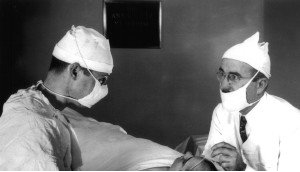Fighting the Legend of the “Lobotomobile”
Many people believe that the developer of the most dreaded form of psychiatric surgery traveled America in a camper van that he slyly called his “lobotomobile.” It’s a myth.

I often receive emails from middle school and high school students working on projects about the history of lobotomy, a now obsolete but once mainstream form of brain surgery intended to treat psychiatric illnesses. Between 1936 and the 1970s, between 40,000 and 50,000 Americans underwent this debilitating and rarely beneficial form of treatment. The young researchers write to me because I’m the author of The Lobotomist, a biography of the lobotomy advocate Walter Freeman. My book tells the story of the lobotomy’s development and sets the infamous procedure in the context of the history of psychiatric treatments and the life of its promoter.
Recently a student asked me to confirm a claim she had read online that Freeman, a devoted cross-country traveler who often undertook long trips to visit his former patients, called his camper-van and mobile office a “lobotomobile.” As much as I admire the cleverness and appropriateness of that term, I had to tell her that Freeman neither coined nor used that name for his vehicle. The nickname didn’t appear until a decade after Freeman’s death.
I’ve wondered whether as Freeman’s biographer I bear the responsibility to fight the persistent appearance of this legend or others associated with the lobotomist’s career, such as the myths that authorities stripped him of his medical license and that he performed lobotomies with a gold-plated ice pick. They’re all fictions, and they are so widespread it would be a gigantic if not impossible task to beat them down.
The misinformation about the “lobotomobile,” for instance, appears in Freeman’s Wikipedia page, in the Encyclopedia Britannica and Damn Interesting blogs, and in several books, as well as in countless other articles, blogs, and publications. The “lobotomobile” nickname even inspired a short movie by the Canadian filmmaker Sara St. Onge. While I enjoy watching this entertaining musical, I suspect it encourages viewers to believe that “lobotomobile” was a name that Freeman actually used.
The word is found nowhere in Freeman’s voluminous published and unpublished writings, including the correspondence, autobiography, memos, and notes he left to the archives at George Washington University in Washington, D.C. Its earliest appearance in print seems to be in an account of one of Freeman’s patient-tracking road trips on page 246 of David Shutts’s 1982 book Lobotomy: Resort to the Knife: “Still uncomfortable from surgery but able to drive, he headed southeast in a newly purchased camper-bus, which could be described as his ‘lobotomobile.’” Shutts’s usage suggests that he invented the word himself.
Perhaps the best way to explain the stubbornness of the myth of Freeman’s “lobotomobile” name is that it efficiently (although falsely) casts the physician as a monster who not only damaged patients’ brains but also mocked them by giving a flippantly humorous title to the van he used to conduct part of his grisly business. Clearly many people want to believe such a thing. But my research has convinced me that Freeman’s patients were too important to him — for reasons rooted in his compassion, hubris, and narcissism— to make fun of them in that way.
In the end, I’ve decided that I don’t have to confront all the wrong statements put out there about my biographical subject. I’ve written a book that offers my perspective of the man in all the complexity of his virtues and failings. Isn’t that enough?
For more information
PBS American Experience documentary The Lobotomist (2008)
References (1)
References allow you to track sources for this article, as well as articles that were written in response to this article.
- Response: instagram searchby Beth Phillips at pikbee on December 12, 2018